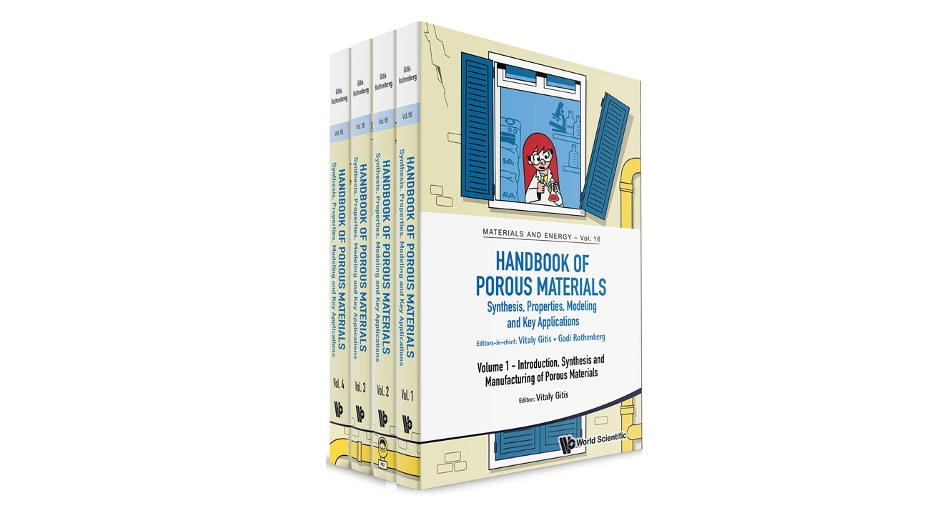State-of-the-art reference work on synthesis, characterisation, and industrial application
A group of authors including researchers and alumni from the Van ‘t Hoff Institute for Molecular Sciences (HIMS) have just completed a four-volume reference work covering the fundamentals and key applications of porous materials. This “Handbook of Porous Materials” will be published in November by World Scientific Publishers in a digital and a print edition. Editors-in-Chief are Prof. Gadi Rothenberg, chair of the Heterogeneous Catalysis & Sustainable Chemistry group at HIMS, and Prof. Vitaly Gitis of Ben-Gurion University, an UvA alumnus and visiting fellow at the Holland Research School of Molecular Chemistry.

Porous materials are used all around us. They are essential for water purification, wastewater treatment, catalysis and industrial separations, but also for batteries, fuel cells and geothermal energy applications. In fact, porous materials are crucial in the very applications that our society needs to succeed in the energy transition and combat climate change. In 2017, having already co-authored a joint textbook on Ceramic Membranes, Rothenberg and Gitis embarked on a much more ambitious project: A state-of-the-art overview of porous materials covering all aspects from synthesis and characterization and simulation all the way to manufacturing and industrial applications.
A hefty handbook
Over the last years, coordinating the efforts of 37 expert authors, the pair constructed the story of porous carbons, ceramics, zeolites and polymers from varied viewpoints: surface and colloidal science, materials science, chemical engineering, and energy engineering. The result is a hefty reference work of four-volumes, containing 14 chapters and more than 1500 pages. The reader will find many high-quality colour illustrations and examples, as well as thousands of up-to-date references to peer-reviewed articles, reports and websites for further reading.

According to Rothenberg, this handbook is the first comprehensive reference work on porous materials since 20 years. “It is especially relevant in the fields of characterisation, simulations, and energy applications”, he says, “where in the past two decades huge progress has been made.”
People might think that reference works are passé in this day and age when everything can be googled, yet Rothenberg disagrees: “The value of a handbook such as this is in the coherence, reliability and quality of the chapters, which are written by the top experts in the field worldwide. We are very thankful that so many of our colleagues from academia and industry agreed to contribute to this work, and we hope that it will help researchers and students all over the world in the years to come.”
Substantial contributions from UvA researchers and alumni
The collaboration includes chapter authors from all over the world, yet the expertise of UvA researchers and alumni is highly visible, including volume editors Tony Kiss (now chair of Chemical Engineering at the University of Manchester) and David Eisenberg (now group leader at the Technion) and chapter authors David Dubbeldam, Marjo Mittelmeijer, Sofia Calero (now professor at TU/e), Thijs Vlugt (now professor at TU Delft) and Raimond Bonné (now at Technology Manager at EuroSupport BV). The handbook also makes use of Dubbeldam’s open-access iRASPA visualisation software to create colourful three-dimensional structure images. Rothenberg emphasises the importance of a strong alumni network: “People who have studied and/or worked at the UvA feel a connection to their alma mater. We should encourage their participation in projects and their visits – this is also a boon to our current students, who get a chance to interact and ask questions. We are already organising such visits through the vehicles of the Holland Research School of Molecular Chemistry, and the UvA’s Research Priority Area Sustainable Chemistry”.

The Handbook of Porous Materials will be published in November by World Scientific Publishers in a digital and a print edition. Volumes 1 and 2 cover the fundamentals of preparation, characterisation, and simulation of porous materials. Working from the fundamentals all the way to the practicalities of industrial production processes, the subjects include hierarchical materials, in situ and operando characterisation using NMR, X-Ray scattering and tomography, state-of- the-art molecular simulations of adsorption and diffusion in crystalline nanoporous materials, as well as the emerging areas of bio-artificing and drug delivery. Volume 3 focuses on porous materials in industrial separation applications, including adsorption separation, membrane separation, and osmotic distillation. Finally, and highly relevant to tomorrow’s energy challenges, Volume 4 explains the energy engineering aspects of applying porous materials in supercapacitors, fuel cells, batteries, electrolysers and sub-surface energy applications.
More information
DOI: 10.1142/11909
Electronic information: Handbook of Porous Materials.
